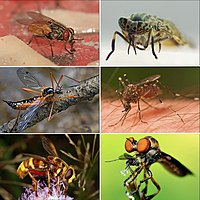
Effects of anti-Leishmania compounds in the behavior of the sand fly vector Lutzomyia longipalpis.
Sign Up to like & getrecommendations! Published in 2022 at "Pest management science"
DOI: 10.1002/ps.6900
Abstract: BACKGROUND Leishmaniasis is an infectious parasitic disease caused by pathogens of the genus Leishmania transmitted through the bite of adult female sand flies. To reduce case numbers, it is necessary to combine different control approaches,… read more here.
Keywords: sugar baits; fly vector; anti leishmania; sand flies ... See more keywords

Broadening the tools for studying sand fly breeding habitats: A novel molecular approach for the detection of phlebotomine larval DNA in soil substrates.
Sign Up to like & getrecommendations! Published in 2019 at "Acta tropica"
DOI: 10.1016/j.actatropica.2018.11.008
Abstract: Phlebotomine sand flies constitute a group of haematophagous insects of great medical and veterinary importance. Despite the significant knowledge on the biology and behavior of adult sand flies in the wild, there is little information… read more here.
Keywords: sand; sand fly; sand flies; soil ... See more keywords

Use of the High-Content Imaging System equipment to evaluate in vitro infection by Leishmania braziliensis in response to sand fly Nyssomyia neivai saliva.
Sign Up to like & getrecommendations! Published in 2020 at "Acta tropica"
DOI: 10.1016/j.actatropica.2020.105540
Abstract: Earlier research has shown that in vivo immunization with sand fly saliva protects the host against infection by parasites of genus Leishmania, and inoculation of saliva along with Leishmania promastigotes favors infection in the host.… read more here.
Keywords: sand fly; infection; content imaging; high content ... See more keywords

Seasonal dynamics of phlebotomine sand flies and autochthonous transmission of Leishmania infantum in high-altitude ecosystems in southern Spain.
Sign Up to like & getrecommendations! Published in 2020 at "Acta tropica"
DOI: 10.1016/j.actatropica.2020.105749
Abstract: Leishmaniasis is a vector-borne disease transmitted by sand flies. A dozen species have been involved in the transmission of Leishmania infantum in the Mediterranean region. Climate change may alter sand fly distribution at particular altitudes… read more here.
Keywords: sand; southern spain; sand fly; sand flies ... See more keywords

Population dynamics of phlebotomine sand flies (Diptera: Psychodidae) in cutaneous leishmaniasis endemic areas of Kurunegala District, Sri Lanka.
Sign Up to like & getrecommendations! Published in 2022 at "Acta tropica"
DOI: 10.1016/j.actatropica.2022.106406
Abstract: Sand flies are the primary vectors of leishmaniasis. Disease management with effective vector control depends on the knowledge of vector population dynamics. In Sri Lanka, despite few isolated entomological collections, long-term studies are not reported… read more here.
Keywords: sand flies; sri lanka; population dynamics; sand ... See more keywords

Th1 concomitant immune response mediated by IFN-γ protects against sand fly delivered Leishmania infection: Implications for vaccine design.
Sign Up to like & getrecommendations! Published in 2020 at "Cytokine"
DOI: 10.1016/j.cyto.2020.155247
Abstract: Leishmaniasis is an unresolved global health problem with a high socio-economic impact. Data generated in mouse models has revealed that the Th1 response, with IL-12, IFN-γ, TNF-α, and IL-2 as prominent cytokines, predominantly controls the… read more here.
Keywords: sand fly; fly delivered; response; infection ... See more keywords

RNA-seq analysis reveals differences in transcript abundance between cultured and sand fly-derived Leishmania infantum promastigotes.
Sign Up to like & getrecommendations! Published in 2018 at "Parasitology international"
DOI: 10.1016/j.parint.2018.03.008
Abstract: Leishmania infantum is responsible for human and canine leishmaniasis in the Mediterranean basin, where the major vector is Phlebotomus perniciosus. Because isolation of sufficient parasites from the sand fly gut is technically challenging, axenic cultivation… read more here.
Keywords: sand fly; fly derived; fly; rna seq ... See more keywords

Glycan–glycan interactions determine Leishmania attachment to the midgut of permissive sand fly vectors
Sign Up to like & getrecommendations! Published in 2020 at "Chemical Science"
DOI: 10.1039/d0sc03298k
Abstract: Direct glycan–glycan interactions are increasingly implicated in survival and pathogenicity of bacteria. Here, we show that they can be exploited by protozoan parasites in their insect hosts. Force spectroscopy revealed that Leishmania promastigotes display a… read more here.
Keywords: sand fly; midgut; fly; glycan glycan ... See more keywords

Density and Shear Strength of Particulate Rubber Mixed with Sand and Fly Ash
Sign Up to like & getrecommendations! Published in 2018 at "Journal of Materials in Civil Engineering"
DOI: 10.1061/(asce)mt.1943-5533.0002322
Abstract: AbstractThe present study examines the behavior of particulate rubber–sand mixtures (PRSM) due to the replacement of sand with fly ash. Particulate rubber (PR) of different gravimetric proportions ... read more here.
Keywords: particulate rubber; rubber; fly ash; sand fly ... See more keywords

Reflection of the Neogene–Quaternary phylogeography in the recent distribution limiting climatic factors of eight Mediterranean Phlebotomus species (Diptera: Psychodidae)
Sign Up to like & getrecommendations! Published in 2018 at "Journal of Natural History"
DOI: 10.1080/00222933.2018.1485981
Abstract: ABSTRACT The diversification of Mediterranean Phlebotomus species occurred during the Neogene and Quaternary periods. The climatic and geographical history of the Mediterranean area plausibly influenced the climatic requirements of recent sand fly species. Our aim… read more here.
Keywords: sand fly; climatic factors; neogene quaternary; climate ... See more keywords

Description of Trichophoromyia velezbernali, a New Sand Fly Species (Diptera: Psychodidae: Phlebotominae) from Colombian Amazonia
Sign Up to like & getrecommendations! Published in 2017 at "Journal of Medical Entomology"
DOI: 10.1093/jme/tjx180
Abstract: Abstract A new species of phlebotomine sand fly, Trichophoromyia velezbernali sp. n. Posada-López, Galvis & Galati, from Colombian Amazonia is described with illustrations and images of male and female adults. read more here.
Keywords: trichophoromyia velezbernali; sand fly; colombian amazonia;